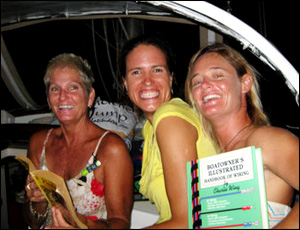Mizzy asks
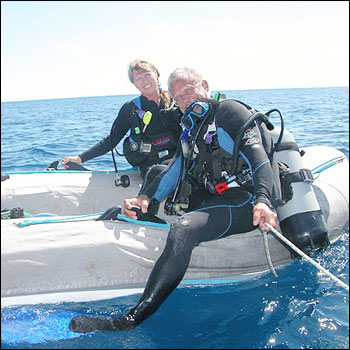 I need your advice about outfitting to scuba dive. We plan to dive a lot. Neither of us does a lot of deep dives. I do have a collection of tanks. I need your advice about outfitting to scuba dive. We plan to dive a lot. Neither of us does a lot of deep dives. I do have a collection of tanks.
What to do? Like all of the outfitting choices we have to make this one will require evaluation of the options. If you could point me towards an informed choice regarding air aboard I would be grateful.Thanks. |
Gwen Hamlin answers
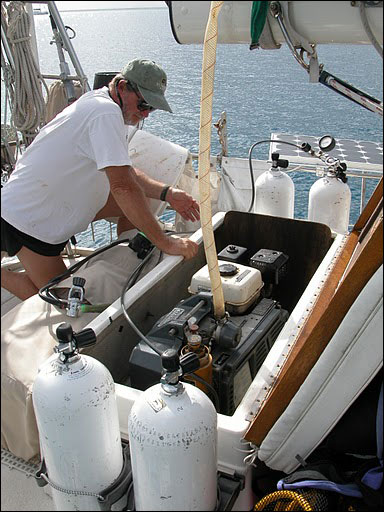 If you love to dive and have room for a compressor, I would go that route instead of the hookah.
If you love to dive and have room for a compressor, I would go that route instead of the hookah.
Lots of people do choose hookahs, but for me, it restricts you to diving somewhere you can have the boat or dinghy. But understand I have no real experience with a hookah other than a long-hose version from a tank on deck we used for cleaning the bottom. The boat we are joining for the summer in Indonesia has a hookah, so I’ll be able to better answer that eventually, but not in time to be helpful to you.
Good friends of ours who didn’t want to carry their own compressor chose instead to carry four tanks. They could each do two dives before needing to fill (plus sometimes a third shallower dive). Often friends had compressors, or there were nearby land-based operations from which to get fills. The reality is that in many places you want to go diving there are dive operations to use. Often, they know and go to the best dive sites available, and using them relieves you of the anxieties of diving on your own.
But, unfortunately, the above is not always true. Some of the best dives we have had have been ones we did on our own. But it does require you conduct your dives with much more vigilance and to equip your boat properly:
We had a Bauer 3.5 cfm gas compressor. Bauers, built in Germany, are pretty international. There are other 3.5 cfm compressors available. You just want to be sure you can get parts, especially filters. I had an electric Bauer compressor on my first boat. It was quieter, but the gas compressor is in the end more efficient, less costly, and more flexible.
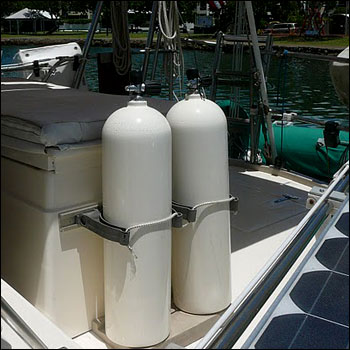 For tanks we had 80 cu ft aluminum tanks. These are the standard in most places.
For tanks we had 80 cu ft aluminum tanks. These are the standard in most places.
However, many cruisers, especially women with good air consumption rates, use the aluminum 50s. They are smaller, so less bulky. But frankly they have the same footprint as the 80s and then you don’t have the air reserve when you wish you did.
Obviously, if you are going to have your own compressor, you will need your own BC and regulator. Don’t go for fancy tricked-out models. Choose basic workhorse models with international distribution so that you can find maintenance anywhere. Even so, ask your home scuba shop to put together a service kit of the basic repair/service parts for your regulator and BC before you leave. Any resort has someone who can service regulators; they may just not have parts for your brand or model.
I recommend a mesh weightbelt to protect your decks with plenty of spare weights. We each had two belts set up in our locker: one for snorkeling and freediving and another heavier one for scuba when wearing neoprene. Also dive computers for both divers, ideally ones that can be set to a safer algorythm than normal (eg my Suunto). When out on our own in Mexico or the tropics, we are more prone to dehydration, which can affect our susceptibility to decompression sickness.
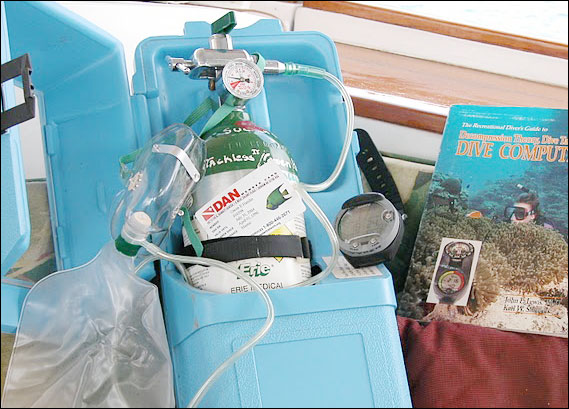 So in addition to keep more conservative profiles, I recommend all independent divers carry an oxygen kit (available from DAN – Divers Alert Network ) and their booklet of emergency procedures. When you are diving on your own, you are totally responsible for yourselves!
So in addition to keep more conservative profiles, I recommend all independent divers carry an oxygen kit (available from DAN – Divers Alert Network ) and their booklet of emergency procedures. When you are diving on your own, you are totally responsible for yourselves!
Try to find someone to do surface watch for you if possible, mind your tides and currents (especially in pass dives in the Pacific) and at the very least “file a dive plan” (i.e let someone else in the anchorage of within radio distance know you are leaving your boat on a scuba dive and what time you should be back.)
Finally, you should also keep current your DAN membership and recompression insurance. Even if you don’t dive, we recommend cruisers carry it just for the air evacuation coverage.
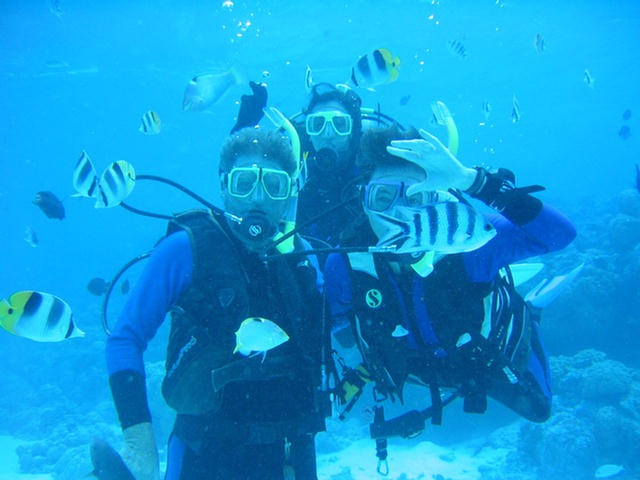 For dive suits, what you use will depend on the water temperatures where you plan to dive. For the tropics, I recommend that you have a dive skin (we used Polartec Fleece neutrally-buoyant suits) plus a 2 mm jumpsuit. Either will protect you from cold and stingy things in most conditions, plus you can layer them up for more warmth. I also carried a neoprene vest and a hood to add for colder waters. Also gloves.
For dive suits, what you use will depend on the water temperatures where you plan to dive. For the tropics, I recommend that you have a dive skin (we used Polartec Fleece neutrally-buoyant suits) plus a 2 mm jumpsuit. Either will protect you from cold and stingy things in most conditions, plus you can layer them up for more warmth. I also carried a neoprene vest and a hood to add for colder waters. Also gloves.
I prefer full-foot-style dive fins (not short, floppy, snorkle fins) to the open heel ones because they are more comfortable for snorkeling, but my husband prefers the open-heel version with booties. I like the idea of booties to have as foot protection and warmth, but I don’t like the idea that my fins will be uncomfortable to use should I lose a bootie! I did end up wearing neoprene socks under my full-foot fins for extra warmth and foot protection.
Some auxiliary equipment I would recommend are a lift bag (in case you need to salvage something heavy…like a lost anchor or outboard!), a marker buoy, and a line on a reel. I can’t tell you how many times we found these items useful. You might also want to have a third regulator set up with a long hookah hose which is mighty convenient for cleaning the bottom or for a quick jump over the side when something gets entangled in your prop.
You will also probably want to have a medium mesh game bag and possible a spear gun. Hawaiian slings are legal most everywhere, but always check local fishing regulations. In Mexico, banded spearguns were prevalent. (The longer the gun, the more accurate!) In the South Pacific, spearfishing quickly dropped off in popularity as the shark population increased. Generally speaking, sharks don’t bother you unless you are spearfishing!
I also recommend carrying a dive knife and an inflatible emergency pylon (I think they are called.) This is a gadget you carry rolled up hanging from your BC which in an emergency you can inflate to make you more visible for someone searching for you on the surface.
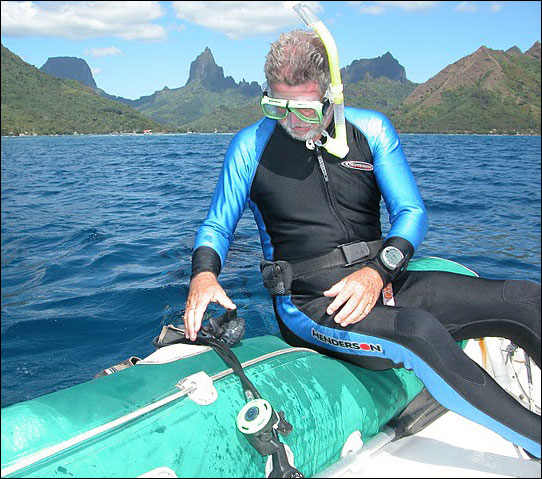 Although in lucky situations you can dive directly from your sailboat, more often you will use your dinghy to reach a site. Therefore, you will want to choose a dinghy that is practical to dive from with an outboard substantial enough to move two people and gear across the water. 15hp will do it.
Although in lucky situations you can dive directly from your sailboat, more often you will use your dinghy to reach a site. Therefore, you will want to choose a dinghy that is practical to dive from with an outboard substantial enough to move two people and gear across the water. 15hp will do it.
For the dinghy you will want a good anchor and a long rode. We used a 15# (I think) folding grapnel with 5′ of stainless (so as not to trash the dinghy with rust) chain, and about 150′ of line. I made it a habit to secure my anchor line twice: once off the bow backed up by a second tied to a stern eye. (In calm conditions I often anchored from the stern.) Finally, you will want to fly a dive flag. I attached mine to a dinghy gaff and stuck it through the handle of the outboard.
You need to be able to get back in your dinghy! The easiest way is to remove your weightbelt, then your slightly-inflated BC holding it by a hose as a tether. Use your fins to then kick yourself up and over the pontoon and then roll to a seated postion with fins still outside the boat. Remove fins, swing around to stand, then heft tank and BC out of the water. I detail this because it’s amazing how many people don’t figure this out! If you can’t kick up out the water, you will need some sort of boarding ladder.
Finally, you need some means of giving your gear a fresh-water rinse. We had a washdown hose on deck connected to a Y-valve in our engine room so that we could switch to fresh water to rinse our gear and ourselves after a dive. If you are doing multiple dives in one location, collect your fresh water in a bucket to reuse. And, remember that all this silicon gear shouldn’t be left out long in the sun. UV is your enemy!
Finally, if you have only Open Water certification, I highly recommend at least Advance Open Water training, plus ideally Rescue Diver so you are better equipped to deal with emergencies. In Advanced Open Water, tell your instructor about your cruising plans. A good instructor can tailor some of the required exercises to simulate situations you might find yourself in cruising (for example, search and recovery of a lost stern anchor or items dropped overboard.) Also, you really want to focus on underwater navigation techniques, since you will have to rely on yourselves to get back to the dinghy. There will be no divemaster up top to come looking for you!
That’s my quick overview of the basics. If I think of anything else I will let you know.
Hope it is helpful.
Gwen
Read also on this website
- Diving In: Preparations & Gear (Admiral’s Angle #47) by Gwen Hamlin
How to prepare you boat and yourself to facilitate in-water activities like snorkeling and diving - Gwen took her SCUBA passion cruising, by Gwen Hamlin
More information (external links)
- Divers Alert Network (DAN): a nonprofit organization that provides emergency medical information and assistance for underwater diving injuries.
If you have a question about going cruising
that you want answered,
email it to: kathy@forcruisers.com
or join the next Women and Cruising webinar!

